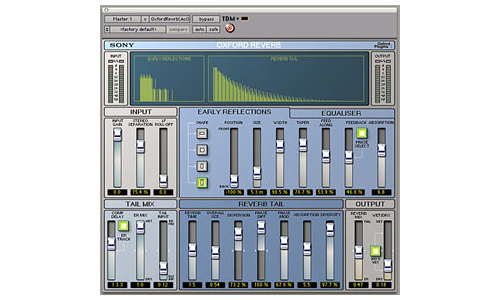The Oxford Reverb plug-in is a highly flexible artificial reverberation generator designed to complement existing Oxford applications in providing the professional user with highest technical and sonic performance coupled with high levels of artistic and creative facility. By avoiding fixed algorithms and providing user control of all parameters, the Oxford Reverb allows the professional engineer the powerful facility to build virtual spaces freely depending on artistic need, ranging from dry reflection ambiences, room and hall simulations, sound effects, all the way to wide open reverberant spaces with a very large range of possible texture and spatial character.

Key Features include:
* Real-time continuous control of virtually all parameters.
* Dual independent paths for both ‘Early Reflections’ and ‘Reverb Tail’ function.
* Each reverb path type can be used independently or in combination.
* Fully controllable five band parametric EQ incorporated into the reverb
* Early Reflections section includes:
o Control of 4 virtual room shapes, all with continuously adjustable sizes.
o Placement of listening position.
o Control of stereo separation of room reflections.
o Control of loudness of reflections in relation to path lengths.
o Variable re-injection of distributed sound within simulated space, controlling reflection density.
o Control of overall feedback where reflected signals are re-circulated.
o Feedback phase control to set reflected diffusion characteristics.
o Variable absorption control which sets the equivalent hardness/softness of the room space.
* Reverb Tail section includes:
o Variable delay compensation to set the timing of the start of the reverb tail using the dry signal. (Can be fixed in ‘track’ mode)
o Reverb tail source cross-fade mix between dry input signal and early reflections signal.
o Final reverb tail source cross-fade mix between compensated dry signal and uncompensated dry / early reflections mix.
o Reverb time control.
o Delay size control which is independent of reverb time, sets the build-up and density of the reverb tail.
o Dispersion control which sets the build-up rate, character and sonic texture over time.
o Phase difference control which works in conjunction with dispersion in order to set the build-up of phase differences between left and right.
o Phase modulation to add time related variance to the reverb character.
o Variable absorption control which sets the equivalent hardness/softness of the room space.
o Diversity function that provides front centre weighting to the reverb tail.
* High pass filter on the input and separate ‘absorption’ controls for each path.
* Over 100 realistic, useful presets divided into sub-catagorised folders
Runs on ProTools|HD Accel, ProTools|HD and ProTools LE systems.
